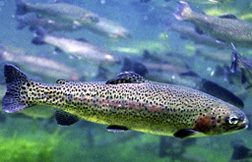This page has been archived and is being provided for reference purposes only. The page is no longer being updated, and therefore, links on the page may be invalid.
Read the magazine story to find out more. |
|
|
ARS, Cooperators Produce New DNA Maps for Rainbow Trout
By Sharon DurhamMarch 4, 2009
New detailed maps of rainbow trout genes and how they relate to key traits like disease resistance, stress response, and growth are being produced by Agricultural Research Service (ARS) scientists and their counterparts in France.
By combining information from genetic maps and physical maps, a more complete picture of the trout genome is created, enabling scientists to pinpoint genes that affect key aquaculture production traits in rainbow trout.
Rainbow trout is one of the most important aquaculture species in the United States and worldwide, but little is known about its genetic makeup.
ARS geneticist Yniv Palti, at the National Center for Cool and Cold Water Aquaculture in Leetown, WV, has an ongoing collaboration with the French National Institute for Agricultural Research scientist Carine Genet to produce the integrated map.
The first-generation physical map of rainbow trout was produced in a collaborative effort by Palti and Ming-Cheng Luo and Yuqin Hu of the University of California-Davis. A physical map shows the specific locations of a species’ genes and/or markers on each chromosome. These types of maps are important for finding physical linkages between traits and genes.
According to Palti, they used variations and similarities among 180,000 trout chromosome fragments to order them on the physical map. Since it is possible to isolate specific genes from chromosome fragments, scientists can now reconstruct the order of the genes and determine whether those specific genes explain certain traits in rainbow trout that influence growth and disease resistance.
Genet sequenced important segments of 100,000 of those fragments and is using the sequence information to design new genetic markers currently being genotyped in Palti’s lab and subsequently being added to the ARS genetic map.
Read more about international research partnerships between ARS and cooperators in the March 2009 issue of Agricultural Research magazine.
ARS is the principal intramural scientific research agency of the U.S. Department of Agriculture.

